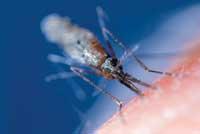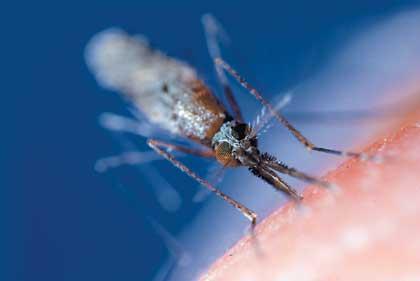The origin of malaria can be in gorillas
2010/10/17 Aulestiarte Lete, Izaro - Elhuyar Zientziaren Komunikazioa

Although known for a long time, malaria remains deadly. The data from the World Health Organization are clear: every year 300 million people are seriously ill and at least one million of them die from malaria. 40% of the world's population is exposed, especially in the poorest countries.
The fight against malaria has gone a long way, but there is still no solution to it. In this sense, new discoveries could be significant.
The University of Alabama (USA) has concluded that the origin of the disease is in gorillas and Nature has given the news. The microorganism Plasmodium falciparum is responsible for most types of malaria in humans and is transmitted by the bite of the mosquito Anopheles gambiae. But so far there was no light on the origin of the parasite.
For clarification, 3,000 excrement samples collected in wild populations of chimpanzees, bonobos and gorillas (sub-Saharan Africa) have been analyzed and the DNA of Plasmodium sequenced. They say that the parasites found in the samples of gorillas of the west of the continent ( Gorilla gorilla) are those that have greater similarity with those observed in humans. And so it has been concluded that this species may be the origin of malaria. “The parasite would pass from the Western gorillas to man, and not from the chimpanzees to man, as previously thought. In addition, we believe that this transmission between species was carried out in a single step, directly”, explains the head of the study.

Looking at the mosquito
The other malaria-related research has been conducted by the National Institute of Allergy and Infectious Disease of Maryland, which has closely observed the immune system of Anopheles. As the disease is transmitted by the mosquito (including Plasmodium in humans), the insect itself must be immune. And that's what they wanted to investigate, how the mosquito is immunized.
In the experiment, mosquitoes were divided into two groups and fed blood from rats contaminated with Plasmodium. One group spread quickly, while the other was not because the insects were in a room that was too hot for the parasite to grow. After a week both groups were fed with contaminated blood. As already contaminated mosquitoes faced the “10 times better” parasite, many survivors with better reproductive capacity than those who were not contaminated.
It seems that granulocytes are responsible for this: researchers found that the number of granulocytes was three times higher in blood from previously contaminated mosquitoes. By detecting some strange cell in her blood, she is attacked by granulocytes.

Researchers have closely observed the immune system of the Anopheles mosquito.
Prior contact with the malaria microorganism is necessary for the formation of granulocytes. In fact, Plasmodium weakens the intestinal walls of the mosquito, so certain bacteria enter the insect's body. It seems that these bacteria become granulocytes to help fight the parasite.
To check it, they repeated the experiment, but administered antibiotics to mosquitoes against intestinal bacteria. The number of mosquito granulocytes did not grow, causing the death of several insects.
Published in 7K.

Gai honi buruzko eduki gehiago
Elhuyarrek garatutako teknologia






